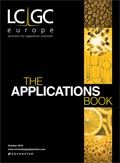Analysis of Monoclonal Antibody Aggregates by SEC Using MS-Friendly Mobile Phases
The Application Notebook
Tosoh Bioscience GmbH
Mass spectrometric (MS) detection has become a standard method in chromatography especially when sensitivity or structure elucidation is an issue. Today, most liquid chromatography coupled to MS (LC–MS) applications are related to small molecule analysis. To make size-exclusion chromatography (SEC), one of the typical LC methods for the analysis of entire proteins, suitable for MS detection, the mobile phase needs to be modified. We illustrate the effective use of MS-friendly mobile phase compositions in the analysis of monoclonal antibody aggregates.
LC–MS is used across a broad range of fields and applications. Typical LC–MS mobile phases consist of volatile buffers and, ideally, a considerable amount of organic modifiers that facilitate the evaporation of solvent during ionization. Typical applications cover the analysis of small molecular weight compounds, separated by reversed phase or hydrophilic interaction. In protein research, LC–MS is commonly applied for the analysis of peptides or glycopeptides after enzymatic cleavage of proteins. For the analysis of large molecules, such as entire proteins, one preferred separation method is SEC, typically combined with UV, fluorescence, or light scattering detection. SEC separates components on the basis of their hydrodynamic radius and needs high ionic strength mobile phase compositions in an effort to minimize ionic interactions between the sample and the stationary phase. Typical SEC mobile phases are therefore not compatible with mass spectrometric detection as the ion source would be immediately blocked by salt. To make SEC–MS an applicable technique, volatile, MS-friendly mobile phase compositions must be implemented. This application note illustrates the effective use of MS-friendly mobile phase compositions in the analysis of monoclonal antibody aggregates using a TSKgel UltraSW Aggregate SEC column. This column demonstrates high stability and low reactivity via ionic interactions even in low salt/no salt environments.
Materials and Methods
Instrumentation: Agilent 1200 HPLC system run by Chemstation®
Column: 7.8 mm × 30 cm, 3-μm TSKgel UltraSW Aggregate
Mobile phases:
A: 100 mmol/L PO4/100 mmol/L SO4, pH 6.7
B: 20% CH3CN/0.1% TFA/0.1% FA
C: 100 mmol/L ammonium bicarbonate, pH 7.0
Flow rate: 1 mL/min
Detection: UV @ 280 nm
Temperature: 25 °C
Injection volume: 10 μL
Sample: TBL mAb 1 (4.0 mg/mL)
Results
Figure 1 illustrates the separation of a monoclonal antibody (mAb 1) using three different mobile phase compositions. All three mobile phases yielded highly similar results for all peak parameters of the monomer. Slightly later elution of the monomer was observed when separated using the salt-based mobile phase. The observed shift in retention time of the monomer peak represents a %RSD of 0.1% among the three mobile phase conditions. Similarly average peak area of the monomer was found to be highly reproducible as well, yielding a %RSD of 0.53% across the three mobile phase systems evaluated in this work. This illustrates that the observed differences in retention time and peak areas obtained from the three mobile phase systems are not statistically significant.

Figure 1: Separation of mAb 1 using volatile and salt-based mobile phase compositions on the TSKgel UltraSW Aggregate column.
As characterization of protein aggregates is of increasing importance in research the antibody was subjected to thermal stress for forced aggregation to evaluate the various mobile phase systems in this context. As shown in Figure 2, aggregates of the antibody are clearly separated from the monomeric species using all three mobile phase compositions. Similar to Figure 1, results for critical peak parameters of the monomer are highly reproducible regardless of the mobile phase composition. In addition, the total peak area (monomer and aggregate) obtained using the three mobile phase systems was highly similar to one another.

Figure 2: Separation of forced aggregated mAb 1 using volatile and salt-based mobile phase compositions on the TSKgel UltraSW Aggregate column.
Conclusions
The growing interest in both protein aggregate analysis and MS in biotech research demands effective SEC–MS methods utilizing suitable mobile phases. The use of volatile mobile phase systems, such as 20% acetonitrile, 0.1% trifluoroacetic acid, and 0.1% formic acid or 100 mmol/L ammonium bicarbonate at pH 7.0, yield highly reproducible separation of antibody aggregates, with similar or better performance over traditional salt-based mobile phase compositions. These results also show the effectiveness of the diol coating on the TSKgel UltraSW Aggregate column to assist in minimizing ionic interactions, which are frequently present between the sample and stationary phase in low salt environments.

Tosoh Bioscience GmbH
Zettachring 6, 70567 Stuttgart, Germany
Tel: +49 (0)711 13257 0 fax: +49 (0)711 13257 89
E-mail: info.tbg@tosoh.com
Website: www.tosohbioscience.de

New Method Explored for the Detection of CECs in Crops Irrigated with Contaminated Water
April 30th 2025This new study presents a validated QuEChERS–LC-MS/MS method for detecting eight persistent, mobile, and toxic substances in escarole, tomatoes, and tomato leaves irrigated with contaminated water.

.png&w=3840&q=75)

.png&w=3840&q=75)



.png&w=3840&q=75)



.png&w=3840&q=75)

















